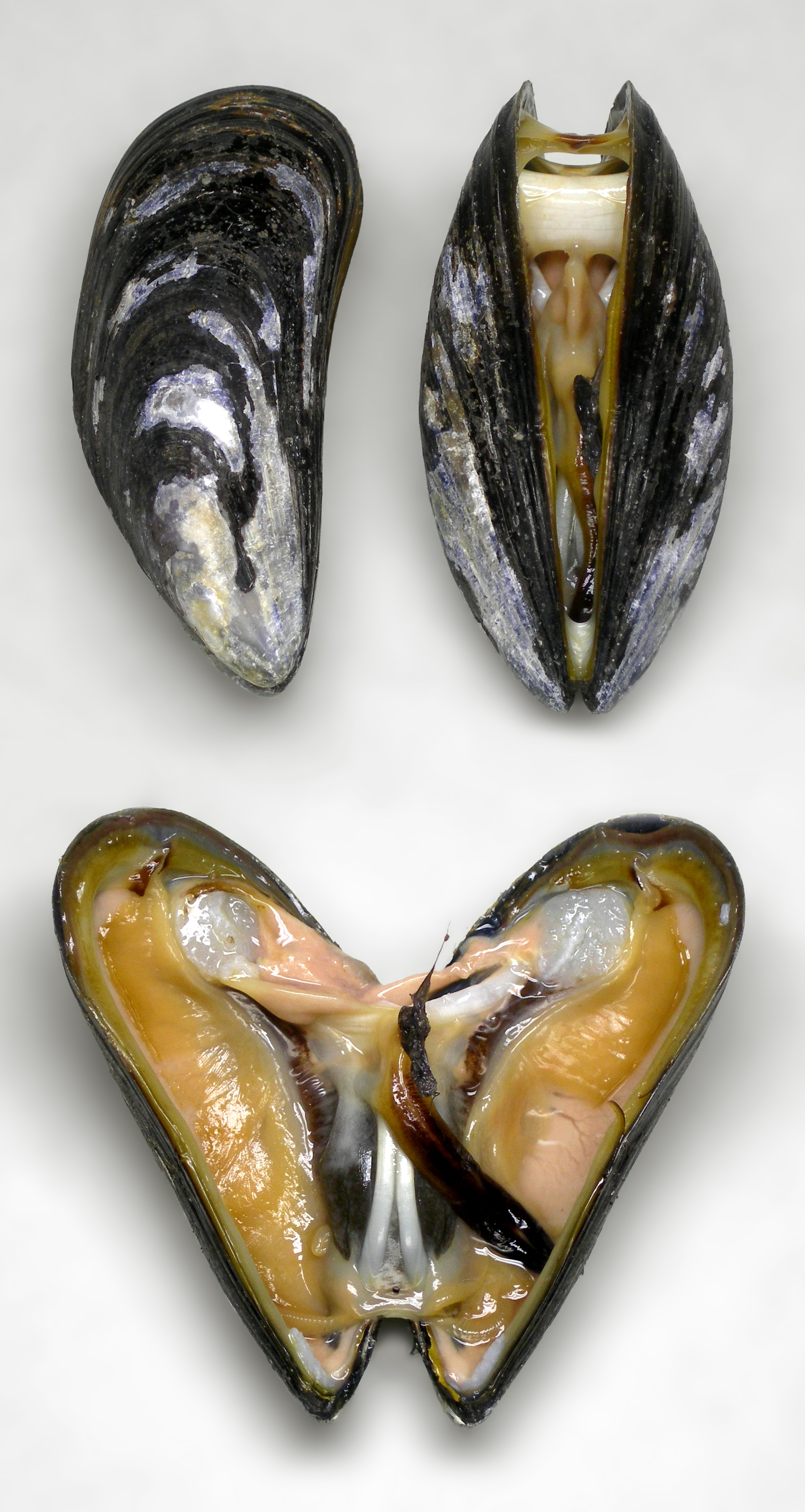
Blue mussel
The blue mussel (Mytilus edulis), also known as the common mussel,[1] is a medium-sized edible marine bivalve mollusc in the family Mytilidae, the mussels. Blue mussels are subject to commercial use and intensive aquaculture. A species with a large range, empty shells are commonly found on beaches around the world.
Systematics and distribution[edit]
The Mytilus edulis complex[edit]
Systematically blue mussel consists of a group of (at least) three closely related taxa of mussels, known as the Mytilus edulis complex. Collectively they occupy both coasts of the North Atlantic (including the Mediterranean) and of the North Pacific in temperate to polar waters,[2] as well as coasts of similar nature in the Southern Hemisphere. The distribution of the component taxa has been recently modified as a result of human activity. The taxa can hybridise with each other, if present at the same locality.
Reproduction[edit]
Mussels have separate sexes. Once the sperm and eggs are fully developed they are released into the water column for fertilization. Although there are about 10,000 sperm per egg,[6] large proportions of eggs deposited by blue mussels are never fertilized. As few as 1% of larvae that do mature ever reach adulthood. The majority are eaten by predators before completing metamorphosis.
The reproductive strategy seen in blue mussels is characteristic of planktotrophs. By minimizing nutrients in egg production to the bare minimum they are able to maximize the number of gametes produced. If the adult mussels are stressed during the beginning of gametogenesis, the process is terminated.[7] When stressed while fresh gametes are present, adult mussels reabsorb gametes. Larvae viability is also affected by the condition of parents: high water temperatures, pollutants and scarcity of food, during gamete production.[7] The reduction in viability is probably due to the lack of lipid reserves distributed to the eggs.
Monitor of environmental DNA damage[edit]
Blue mussels are used for monitoring marine pollution based on their tendency to accumulate numerous pollutants from their natural environment.[8] Upon in vivo exposure of blue mussels (Mytilus edulis) to either of two metals of environmental concern, cadmium or chromium, it was found that both of these metals induce DNA strand breakage, and also impair different DNA repair capacities in the tissues of these mussels.[8]
Larval development[edit]
Larval development can last from 15 to 35 days depending environmental conditions including salinity and temperature, as well as location. Larvae originating from Connecticut mature normally at 15–20 °C (59–68 °F), though at 15 °C (59 °F) normal development occurs at salinities between 15 and 35 ppt and at 35 ppt at 20 °C (68 °F).[9]
The first stage of development is the ciliated embryo, which in 24-hours for fertilization form the trochophore. At this point although mobile, it is still reliant on the yolk for nutrients. Characterized by a functional mouth and alimentary canal the veliger stage also has cilia which are used for filtering food as well as propulsion. A thin translucent shell is secreted by the shell gland forming the notable straight hinge of the prodissoconch I shell. The veliger continues to mature forming the prodissoconch II shell. In the end stage of veliger development photosensitive eye spots and elongated foot with a byssal gland are formed.[10]
Once the pediveliger is fully developed, its foot extends and makes contact with substrate. The initial contact with the substrate is loose. If the substrate is suitable, the larva will metamorphoses into the juvenile form, plantigrade, and attach byssus threads. The mussel will remain in that state until reaching 1-1.5mm in length. This attachment is the prerequisite for the foundation for the blue mussel population. In sheltered environments large masses sometimes form beds which offer shelter and food for other invertebrates. Byssal thread are secreted by byssal glands located in the foot of the mussel, and are made up of polyphenolic proteins which serve as a bioadhesive.[10]
Predators[edit]
Predation of blue mussels is greatest during the three weeks it spends as a planktonic larva. During this stage it is susceptible to jellyfish and fish larvae through adults. Once it metamorphoses the mussel is still restricted by predation, with smaller mussels with thinner, weaker shells most affected. Once the shells becomes stronger, blue mussels are preyed upon by sea stars such as Asterias vulgaris as well as by several species of sea gulls. The capability of shell thickening by mussels has become a very effective defense mechanism. In the presence of predators a mussel is able to increase shell thickness 5 to 10 percent, which in turn makes opening the shell take 50 percent more time.[15] Small mussels are also eaten by the dog whelk, Nucella lapillus.[16] The blue mussel is host to a wide range of parasites, but these parasites usually do not cause much damage. Blue Mussels are able to fight off one species of predator at a time such as sea star (Asterias rubens (=Asterias vulgaris)) or green crabs (Carcinus maenas). They use their inducible defenses to strengthen their adductor muscle or grow thicker shells. When faced with two species at a time, they are no longer able to use their defenses and can be killed more easily.[17]




